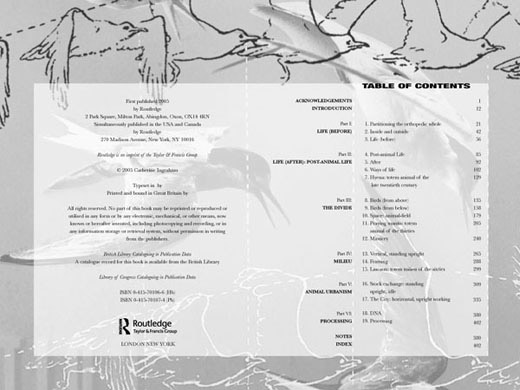
Architecture, Animal, Human
Taking something from inside the book out to the outside, in order to return it, in a recursive and iterative way, in a spatial interplay, back to the inside.
2004-5
With many books, as with many building, between the outside (cover) and the inside (pages) there is little if any direct graphic relation. In this book we wanted to take something from inside the book out to the outside, in order to return it, in a recursive and iterative way, in a spatial interplay, back to the inside.
There is a startling moment in Claude Levi-Strauss’ Totemism when he asks, echoing Radcliffe-Brown's quizzical remarks about the ubiquity of bird totems in certain cultures, “Why all these birds”?
— Catherine Ingraham, Architecture, Animal, Human
Why all these birds, then, in this book? Birds figure prominently, literally and figurally, in Ingraham’s book, as a means for the author to discuss animate structure across a number of different disciplines. Chapter 8 is entitled “Birds (from above)” and Chapter 9 “Birds (from below).” The birds we chose to be above and below on the cover were taken from a book cited by the author: from the Etienne-Jules Marey motion diagram in Siegfried Giedion’s Mechanization Takes Command (see Figure 8.3, pp. 152-3). We treated Giedion’s book inside Ingraham’s book as a book (spread) within the book, while outside on the cover a portion of the Marey diagram is used as a foreground overlay. The graphic birds were thus drawn to the cover, positioned on and off the register with the photographic birds, one image from a photo series of natural history dioramas used as background underlays in the book.
We placed the Marey bird diagram on the cover as a way of setting up guidelines subsequently used throughout the book: in the measure and positioning of the text and image fields inside the book, as well as in the author name and titles on the cover and spine, which then were developed into the chapter and side titles inside the book. The front matter sets up and plays out the evolving influence that pervades the book, recursively emphasized as the table of contents continues to emerge in the section divider pages, with each particular section drawn forth with its companion quotes. The Marey birds begin to appear again in the back matter, in the index pages, faintly at first, then more intensely as they fly up and off the page as the book ends.








